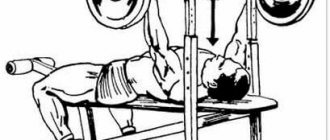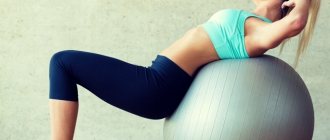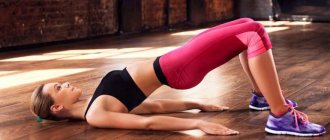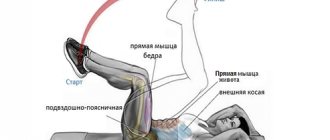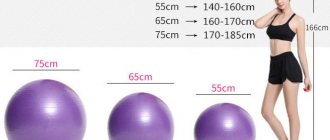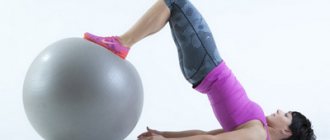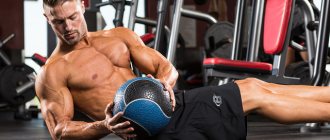What is a fitball and what is it for?
A gymnastic ball is the simplest type of universal exercise equipment. It is suitable for many exercises and can be used as a main element or as a simulator that complicates the movement. Made from durable rubber material that can withstand enormous loads. The fitball is inflated with ordinary air, which, with the exception of incredible strength, makes it similar to balloons.
Read more about exercises on a fitball →
The main directions in training with fitball:
- Strength training (only with your own body weight, no weights).
- Gymnastic movements.
- Yoga exercises and static positions.
- Recovery and rehabilitation.
This wide range of capabilities makes the large fitness ball a completely versatile exercise machine that is suitable for any training purpose.
Fitball - what is it?
Fitball (fitball or fit ball) is an elastic gymnastic ball of large diameter made of rubber, filled with air and equipped with an anti-explosion safety system.
It comes in various colors and modifications, and is designed for physical exercise.
This is a mobile exercise machine that can be easily deflated and placed on a shelf, or taken with you on a trip.
The gymnastic ball was invented by Swiss physiotherapist Susanne Kleinvogelbach, who was developing special programs for children suffering from cerebral palsy (CP). After some time, the baton with the ball was taken over by the American doctor Joan Posner Mauer. She used a fitball for the rehabilitation of patients who had suffered spinal injuries, since during exercise there was no load on the legs. And later the recognition of the gymnastic ball as a sports equipment spread throughout the world.
The benefits and harms of exercising on a fitball
In terms of benefits and contraindications, a gymnastic ball is the best exercise machine. It has virtually no flaws.
Main advantages:
- The ability to vary the load from incredibly simple to complex (complication of ordinary strength and gymnastic movements).
- Development of flexibility, coordination of movements and balance.
- Health-improving load on the spine and joints.
- Effective burning of calories and fat burning. Read more about fitball exercises for weight loss →
- Natural development of aesthetic muscles.
- Working out all the muscles of the body (including the deep layers).
Thanks to such advantages, a fitness ball is called one of the safest and most useful exercise equipment. It can be found in most rehabilitation centers. Also, a fitness ball is the best exercise machine during pregnancy. However, the only limitation is the first trimester. When any load is contraindicated. In other periods, such training (under the supervision of a specialist) will be useful.
Benefits of training on a fitball
Fitball training has some significant advantages that set it apart from other fitness areas, namely:
– Exercises on a fitball have almost no restrictions, they can be practiced by those who are undergoing rehabilitation after sports injuries, pregnant women and women who have recently given birth, patients with varicose veins (the load on the legs is weak), those who have problems with the spine and back;
– This type of training helps to straighten posture and solve many problems with the spine by effectively strengthening the muscular corset (there are even special complexes for those diagnosed with lumbar osteochodrosis, kyphosis, scoliosis, etc. spinal problems);
– Physical activity when exercising on a fitball is distributed evenly throughout the body, which allows you to pump different muscle groups;
– Thanks to the fitball, the vestibular apparatus is excellently trained, since you have to constantly maintain balance;
– Due to the instability of the fitball, you have to put in extra effort when performing exercises, which increases the effectiveness of training by almost 2 times, and constant muscle tone during exercise helps to achieve a beautiful figure relief;
– A fitball can be used for stretching and warming up joints – it will provide the necessary support and make stretching more comfortable;
– This type of exercise stimulates metabolism, improves blood flow, helps normalize the functioning of the respiratory, cardiovascular and nervous systems;
– Fitness with a fitball helps women prevent some diseases of the genitourinary system due to increased blood flow and massage in the abdomen and thighs;
– During training on a fitball, a gentle massage occurs, which improves skin elasticity and helps break down hard fatty cellulite accumulations;
– Since during training on a fitball a large number of muscles are involved, and the exercises themselves are not easy, this improves weight loss results;
– Young mothers can train on a fitball together with their babies – such joint training will bring benefits and joy to both, and the mother will not have to figure out where to put the baby during classes.
Types of fitballs
There are several types of simulators. Therefore, before choosing a fitball, you need to understand the characteristics of each type. Initially, all simulators are divided into categories of diameter, stiffness and type of construction.
By type they distinguish:
- With spikes or gymnastic massage ball.
- With horns (handles) - for additional balance. Basically, such models are considered for children.
- Smooth is a universal type, the most popular in sports.
- "Peanut" - suitable for strength sports and for recovery from injuries.
In most cases, a smooth ball is suitable as it is the most versatile. A gymnastic massage ball is better during rehabilitation (it creates an additional massage effect during work) and also when fighting cellulite, when you need to tighten the skin and break down fat deposits.
Fitball - benefits, harm and exercise options
A fitball is a large elastic ball with a diameter of up to 1 meter. It is used for training at home and in the gym. Fitness instructors include exercises with a fitball in aerobics, Pilates, strength training, stretching and gymnastics for pregnant women.
Initially, fitball was used in the rehabilitation of newborns with cerebral palsy. The first fitball was developed by Swiss physiotherapist Susan Kleinvogelbach in the 50s of the 20th century. Exercises with a gymnastic ball had a strong effect that it began to be used in the practice of recovery from injuries to the musculoskeletal system in adults. Since the 80s, fitball has been used not only in therapy, but also in sports.
Types of fitball
Fitballs differ in 4 parameters:
- rigidity;
- diameter;
- color;
- texture.
Stiffness or strength depends on the quality of the material from which the ball is made and the degree of “inflation”.
The diameter varies between 45-95 cm and is selected based on individual characteristics and preferences.
The texture of the fitball is:
- smooth;
- with small spikes - for a massage effect;
- with “horns” - for children.
How to choose a fitball
- When purchasing, pay attention to the inscription BRQ - Burst Resistant Quality, ABS - Anti-Burst System, "Anti-Burst System". This means that the ball will not burst or tear during use.
- Find the mark with the maximum weight that the fitball is designed for. This applies to overweight people and those who use weights to exercise on the ball.
- Not all manufacturers include a pump with the fitball. You don't have to buy one: a bicycle pump will do for inflation.
- In the store, do a test to determine the appropriate size. Sit on the ball and make sure that the angle at the knee becomes 90-100º, and the feet are completely on the floor. If the diameter is incorrectly selected, it is impossible to achieve correct posture while sitting on the ball, as the load on the joints and spine will increase.
- Do not confuse a fitball with a medicine ball - a medicine ball that acts as a weighting agent.
The benefits of fitball
Exercises with a fitball help diversify your regular workouts and strengthen your body. The fitball will help you improve your stretching and become flexible.
General
While playing with the ball, a lot of concentration is required. More muscles are used for balance, which helps strengthen them.
For the press
Fitball exercises are an effective way to develop the abdominal and thigh muscles. During training with the ball, deep muscles are worked out, which rarely function during standard exercises.
For posture
Exercises on a fitball do not overload the back and allow people with injuries to the spine and musculoskeletal system to stay in shape. Regular exercise improves posture and reduces back pain.
For coordination
When performing exercises with a fitball, coordination improves, which allows you to learn to balance on unstable surfaces and develop the vestibular apparatus.
For the mood
Exercises with a fitball have a beneficial effect on the nervous system, elevate your mood, relieve stress and tension.
For heart
During training with a fitball, the functioning of the heart and lungs improves.
For pregnant
With a fitball, you can perform exercises to keep fit without fear of harming your unborn child.
Fitball training for pregnant women is carried out to prepare muscles for childbirth. Positive effects of training for expectant mothers:
- relieving tension from the lumbar region;
- relaxation of the muscles surrounding the spinal column;
- normalization of the circulatory system;
- strengthening the muscles of the pelvis and back.
Exercises with a fitball are allowed after the 12th week of pregnancy in consultation with your doctor.
For babies
Fitball exercises with newborns can be carried out in the 2nd week of life.
Benefits from classes:
- development of the vestibular apparatus;
- relieving muscle hypertonicity;
- stimulation of internal organs;
- strengthening the abdominal muscles and limbs.
During classes, observe the child’s reaction: if he begins to act up, stop the exercises and postpone until next time. The first lessons should not last more than 5 minutes.
For children
During exercises with a ball, the child develops all muscle groups, improves endurance, coordination and normalizes the functioning of the digestive organs. The duration of training with a fitball for a child is 30 minutes.
Harm and contraindications
- first trimester of pregnancy and problems with its course: isthmic-cervical insufficiency, threat of miscarriage and increased uterine tone;
- severe spinal injuries, including herniated discs;
- heart diseases.
Recommendations for pregnant women
Do not make sudden movements to avoid injury or deterioration of health.
Effective exercises in later stages:
- swing to the sides while sitting on the ball;
- perform short “springy” jumps.
How to properly exercise with fitball
Exercises with a fitball are performed in one or several positions: sitting, lying and standing. All complexes are divided into 3 types: for stretching, relaxing or strengthening muscles.
The recommended time for a full workout with a fitball for an adult is 40 minutes. The rest break between exercises should not exceed 30 seconds. During the exercise, try to tense your muscles as much as possible.
Here are a few exercises with a fitball.
For women and men
- Starting position - standing, arms at your sides, feet shoulder-width apart, knees slightly bent, back straight, stomach tucked. Take the ball in your hands, bring it up above your head, then, while inhaling, bend over with straight arms and without arching your back, moving your pelvis back, as if you were doing a squat. As you exhale, straighten up and return to the starting position. Try to keep your back muscles tense. Perform 3 sets of 5 reps.
- Starting position: lying down, face up. Position your upper body on the ball so that your head and shoulders are resting on the exercise ball. Keep your pelvis suspended, legs bent at the knee at an angle of 90º. Perform cross swings: as you exhale, touch the toe of the opposite leg with your hand. Perform 3 sets of 20 reps on each side.
For pregnant
- Starting position - standing, feet shoulder-width apart, dumbbells in hands. Place the ball between the wall and your back at lower back level. Squat down so that the ball rises to the level of your shoulder blades. Keep your back straight. Perform 3 sets of 8 reps.
- Starting position - sitting on a fitball, knee angle 90º, legs spread. Bend your body to each side with your arm outstretched. Perform 2 sets of 5 reps on each side.
For children
- The exercise is designed for children up to 1 year old. Place the baby face down on the fitball, grab him by the legs and roll him and the ball back and forth 5-6 times. During the exercise, you can lift the lower part of the child’s body by the legs and continue to perform similar actions.
- The exercise is designed for children over 5 years old. Starting position - lying on your back, arms extended along the body, fitball clamped between the ankles. Raise your legs together with the ball, then return to the starting position. Repeat 5-6 times.
How to choose a fitball
Once you have decided on the type, you need to choose the size of the fitness ball. For this, a universal table of the relationship between height and diameter of the simulator is used (weight is usually not taken into account, since almost all fitballs can withstand a load of up to 300 kg). The arm length ratio can also be used, although this calculation does not take into account individual characteristics (for example, long arms with short stature).
How to choose a fitball based on height and weight
Standard mesh:
| Height (cm) | Diameter |
| 150-160 | 55 |
| 160-170 | 65 |
| 170-180 | 75 |
| 180-190 (and higher) | 85 |
There is also a way to determine the size by arm length . It is less correct and is used as an additional method. To calculate, take the length of the arm from the shoulder to the nails.
- For example, with a length of 66-75 cm, a 65 cm fitball is suitable.
- If the arm length is higher than this value, the gymnastic ball is 75 cm.
What else to pay attention to
In general, there is a huge selection of different balls on the market, both from expensive and well-known brands, as well as budget models from unknown manufacturers. There is no particular difference between the balls, if you do not take into account different technologies (for example, the design of massage-type spikes).
The most important condition when choosing a model is the presence of a pump . It is necessary to pump up the fitball. If it is not included in the kit, then you need to buy the pump separately. Without it, you won’t be able to pump up a fitness ball.
Top brands
Fitballs from some brands have proven themselves to be reliable and of high quality. Among these it is worth highlighting:
- Starfit GB-102 – has anti-explosion technology, does not slip, a pump is included in the initial package.
- Togu MyBall Soft is a simple and durable ball. Thanks to anti-explosion technology, it is protected from sudden deflation even if damaged.
- Bradex SF 0171 is a “peanut” class model. It is used both in strength sports and for recovery from injuries. Designed for heavy people, it can withstand up to 150 kg of direct load.
- Indigo IN004 is a popular model with a mustache for children. The surface does not slip, and the elastic material allows it to withstand loads of up to 150 kg.
Exercises with fitball
The first exercise with a fitball according to the Pilates system is for the abdominal muscles. You need to sit on the ball and start walking forward with your feet. The ball will be located approximately in the middle of your back. Don't forget about bent knees - they should be located above the heels. Hips are at the level of the knees and shoulders, straight arms are located behind the head. First, we pull our hands to the floor, after that we put our palms on the back of our heads, without clasping them. We tear off the shoulder blades, head and neck from the ball. After this, we carefully return to the starting position and do the same 8-10 more times.
If you want to do the kind of Pilates exercises with a ball that will make your abs look great, then the following will probably suit you. You need to lie on the floor and place your bent legs on the fitball, place your palms under the back of your head, and fix the ball itself with your heels. We inhale, exhaling, lift the ball, pulling it towards us. Having raised the ball, you need to hold it in this position, and then smoothly lower it. Repeat 8-10 times.
By doing Pilates exercises with a ball, you can achieve a lot - a beautiful back, weight loss and increased tone are guaranteed. Now you need to lie on the floor, bend your knees and place your feet on the fitball, place your hands along your body with your palms down. Inhale, press your feet toward the ball, exhale, tighten your abs, and then lift your pelvis and back so that your body forms a straight line. You must remain in this position for five inhalations and exhalations, and then carefully return to the starting position. The exercise is done in 5 approaches.
If you do Pilates with a ball, you will soon get slender legs. The next exercise is dedicated to them. You need to lie down, lean on your arms bent at the elbows - while the elbows should be located above the shoulders. We hold the ball between the ankles, the legs are bent at the knees, and the abs are tense. As you exhale, lift the fitball off the floor with your feet and lift it. The number of repetitions is at your discretion.
The main advantage of Pilates on a ball is that even inactive muscles are developed, and unnecessary stress is removed from the lower back and joints. At the same time, the effectiveness of such gymnastics is obvious. If you want to do Pilates on a weight loss ball, then the following exercise is perfect for you - you need to lie on your stomach on the fitball, rest your palms on the floor. You need to move forward so that the ball is under your hips, place your palms so that they are under your shoulder joints. After this, we stretch the body in one line and do push-ups, about 8-12 times. The exercise can be made more difficult by placing a fitball under your shins.
Before you start doing such gymnastics, you need to clarify one more nuance - the size of the fitball. Maybe you'd be better off doing Pilates with a small ball? Here it all depends on the person’s height - if you are less than 160 centimeters, then you should take a fitball with a diameter of 55 cm. For everyone else thinking about how to choose a Pilates ball, you should use a 65-centimeter ball. You can simply check it - you need to sit on it so that your knees are above your ankles. With a proper ball, your thighs will be parallel to the floor.
How to pump up a fitball
You can inflate a fitball at home; all you need is a pump. Many manufacturers add it to the kit, otherwise you will have to purchase the pump separately.
After connecting the pump to the special hole on the ball, inflate it to a volume of 80-85%. Never inflate the ball completely.
- Firstly, this increases the risk of damage during intensive work.
- Secondly, it will reduce softness and increase the shock-absorbing load on the muscles during use.
How to inflate a fitball without a pump
Main types of exercises on a fitball
With the help of a fitball you can pump up absolutely any muscle in the body. We will give you only the most standard exercises that are most effective in the process of losing weight:
1. Abdominal workout
Place your hands on the floor shoulder-width apart, place your feet at the hips on the fitball - now do push-ups while maintaining your balance on the ball. Do 10-20 push-ups in several approaches with pauses or changing exercises.
When this type of push-up becomes easy, start doing push-ups with your feet, not your hips, on the fitball. As an alternative, you can practice reverse push-ups, with your feet on the floor and your hands resting on a stability ball. With this type of push-up, you will aim your body towards the ball, and not towards the floor surface.
2. Training the hips, buttocks and lower back muscles
Extend your arms straight in front of your chest and hold the exercise ball in them. Now squat with a straight back, trying not to bend forward. To pump up your inner thighs, hold a fitball between your legs at knee level, now squeeze and stretch the ball so that it does not fall.
You can jump with a ball held between your legs. A good cardio workout is running in a circle while jumping over a fitball.
3. Chest workout
Sit on a gymnastics mat, spread your legs wide and place a ball between them. Now squeeze the ball tightly with your hands, constantly increasing the degree of compression. This way you will pump up the muscles of your chest and arms.
4. Abdominal and leg muscle training
Lie down on a gymnastics mat, stretch your arms along your body, and hold the fitball with your feet near your feet. Now lift your legs with the ball and throw them over yourself so that the ball is behind your head. This exercise helps strengthen the muscles of the back, abdomen and legs.
5. Core workout
Lie on your stomach on an exercise ball with your arms and legs on the floor. Now slowly roll on the ball so that you gradually move forward without removing your hands and feet from the floor.
Next, sit on your knees, place the fitball at a distance from you, and rest your palms on it. Straining your stomach to the maximum, smoothly roll forward so that instead of your palms, your elbows rest on the fitball. Perform the exercise slowly and make sure that the ball does not roll away.
6. Leg workout
Place one foot on the exercise ball, and now squat on the other leg. Do 10-15 squats and then switch your legs.
7. Butt workout
Kneel down, now lift one leg and straighten it. Swing with your outstretched leg, throwing it over the fitball lying next to you. With this exercise, the load on the buttocks and hips will be significant, so choose a ball only with a diameter that matches your height.
Can a fitball burst?
Repeated testing has shown that the balls are incredibly durable and require conscious effort (such as being placed at a certain angle and high pressure) to damage them. During normal work with the simulator, damage to it is possible only if the ratio of the athlete’s weight and the class of the ball is incorrect (for example, a children’s simulator for a man weighing 120 kg or more).
Also, almost all fitballs are equipped with anti-explosion technology, which eliminates the risk of the ball bursting. Even if the integrity of the chamber is compromised, the fitball will deflate gradually. This allows you to avoid getting injured and not jumping off a burst machine during the exercise.
And also read: Exercises on a fitball for the buttocks and legs → Exercises on a fitball for the abs → Exercises on a fitball for the back →
Straight twist
We are already familiar with this exercise from the previous complex, this is exercise 2 (we twist the body while lying with our backs on a fitball). The difference is that after 15-20 repetitions, the arms are extended forward and several more movements are performed with less amplitude and greater speed. In this case, you need to avoid straining the neck muscles. You need to finish the exercise with stretching. To do this, straight arms are moved behind the head, the abs relax, and the torso bends. You can spring the ball a little.
If you want to buy a gym ball, you should pay attention to the right size. Larger people choose a diameter of 75 centimeters. You should absolutely try before you buy. “If you're sitting on it and your feet are firmly on the ground, your hips should be slightly down, your hips should be slightly above your knee joints, your top should be slightly forward,” Kunt explains. Due to air pressure, gymnastics balls may need to be slightly adjusted to fit the body size. A reverse healing expert will use anti-sleeping bursts that don't rip as easily.
Such actions allow you to effectively stimulate the muscles to their full depth. You cannot perform them to the point of mortal fatigue, but the burning sensation in the muscles indicates the effectiveness of the actions.
Video tutorial: straight crunch with a fitball
The starting position is the one in which the previous exercise was completed, that is, the fitball is under the back, the heels are firmly on the floor. It is necessary to perform a tuck, like a boxer in defense: the chin is brought to the chest, the arms are bent at the elbows and pressed against the body, which rises slightly. Begin circular movements of the body, first in one direction and then in the other direction. At the same time, you need to ensure that your abs are constantly tense and your head does not lean back.
The cost of the gym ranges from 10 to 40 euros. On and off: the main position is on the ball. Then you check a few times and sit down again. This exercise stimulates the cardiovascular system and promotes coordination and balance.
Plan: When you're on the ball, you train your entire body. You kneel behind the ball and support your hands. Hands at an angle. Then the knees rise. This exercise also works on pages. Crunch: With this classic abdominal exercise, you lie on your back on a ball. The legs are positioned at an angle. The upper body is slightly raised and supported.
The exercise ends with the same stretching as the previous one, after which you need to roll on the ball and give your torso a vertical position by sitting on it. In addition to the abs, this exercise involves the oblique abdominal muscles, and its implementation helps not only to achieve an ideal flat stomach, but also to remove the “extra” on the sides.
Exercises on a fitball for the back and abs
Bridges: You lie on your back with your heels on the ball and your shoulders and arms on the ground. The palms of the hands are directed upward. The stand then rises. The back should remain extended. Squats: You grab the ball and squat. The ball is held with outstretched arms above the head. It strengthens the legs, buttocks, arms and chest.
Push-ups with a fitball
All gym ball fitness exercises are very friendly and versatile for you. They strengthen the muscles of your entire body and make it easy and convenient to train from home. All you need is soft ground and a fitness or gymnastics ball. Take a look at fitness exercises from a personal trainer and find out what works best for your fitness training. If you do gymnastics exercises regularly, you will soon notice significant progress in your fitness and figure.
